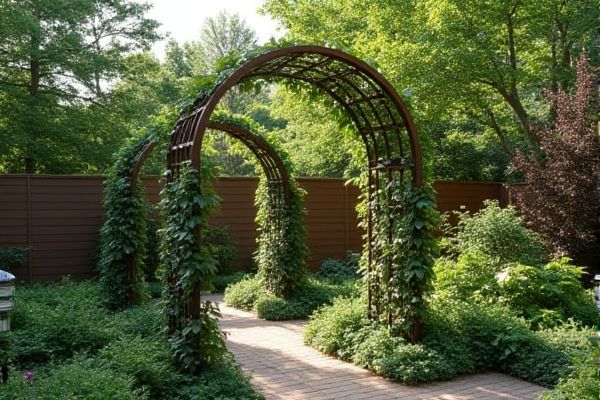
Vertical trellises provide strong, upright support ideal for climbing plants, optimizing space in smaller gardens, while obelisk trellises offer a sculptural focal point with a pyramid-like structure that enhances garden aesthetics and plant growth. Discover how to choose the perfect trellis to elevate your garden's design and functionality by reading the rest of the article.
Table of Comparison
| Feature | Vertical Trellis | Obelisk Trellis |
|---|---|---|
| Structure | Flat, vertical panel | Tall, pyramid-shaped frame |
| Space Usage | Requires wall or fence support | Free-standing, occupies less horizontal space |
| Plant Support | Ideal for climbing vines and espalier plants | Perfect for climbing roses, clematis, and beans |
| Aesthetic | Classic, neat, and minimalistic look | Decorative, sculptural garden accent |
| Installation | Requires secure mounting on a vertical surface | Easy to place anywhere in garden |
| Durability | Stable if mounted properly | Stable due to pyramid shape but may need anchoring |
Introduction to Vertical and Obelisk Trellises
Vertical trellises provide a practical solution for supporting climbing plants, maximizing garden space by growing plants upward along a flat, sturdy framework. Obelisk trellises offer a decorative and functional alternative, featuring a tapered, pyramid-like structure that supports plants while enhancing landscape aesthetics. Your choice depends on available space and design preference, with vertical trellises ideal for narrow spots and obelisks adding architectural interest.
Key Differences Between Vertical and Obelisk Trellises
Vertical trellises feature a flat, upright structure ideal for training vines and climbing plants directly upward, maximizing space efficiency and ease of maintenance. Obelisk trellises have a pyramid-like shape, offering 360-degree growth opportunities, better decorative appeal, and support for plants like clematis or sweet peas that need both vertical and outward climbing. The key differences lie in their shape, plant support style, and visual impact, with vertical trellises suited for narrow spaces and obelisks enhancing garden aesthetics while supporting multiple vine directions.
Design Features: Structure and Aesthetics
Vertical trellises feature a flat, panel-like structure ideal for supporting climbing plants with a sleek and space-saving design, while obelisk trellises have a three-dimensional, pyramid-like frame that adds a sculptural focal point to gardens. The vertical trellis offers a modern, linear aesthetic suitable for walls or fences, whereas obelisks create vertical interest and visual depth in garden beds or containers. Both structures provide sturdy plant support but cater to different stylistic preferences and spatial needs.
Space Utilization and Garden Layout
A vertical trellis maximizes space by encouraging plants to grow upward along a flat surface, making it ideal for narrow garden beds or against walls where horizontal space is limited. In contrast, an obelisk trellis utilizes vertical space in a three-dimensional manner, allowing plants to climb around all sides, enhancing your garden's aesthetic appeal while occupying less ground space. Choosing between the two depends on your garden layout and how efficiently you want to use available space for climbing plants.
Supporting Different Types of Plants
Vertical trellises are ideal for supporting climbing plants like cucumbers, peas, and beans, offering strong vertical growth space that maximizes garden area. Obelisk trellises work best for vining flowers such as clematis and morning glories, providing a decorative, three-dimensional structure that supports sprawling tendrils. Selecting the right trellis depends on your plant's growth habits and the visual impact you want to achieve in your garden.
Installation and Maintenance Requirements
Vertical trellises require straightforward installation with secure anchoring to walls or fences, making them suitable for limited spaces, while obelisk trellises often need freestanding placement and stable ground for proper setup. Maintenance for vertical trellises typically involves periodic inspection of fasteners and cleaning surfaces, whereas obelisks may require examination for structural integrity and occasional repositioning to prevent tilting. Your choice depends on available space and willingness to manage either wall-mounted or garden-centered support structures.
Durability and Material Choices
Vertical trellises are often crafted from treated wood or powder-coated metal, offering excellent durability against weather elements and providing sturdy support for climbing plants. Obelisk trellises typically feature metal or resin materials designed for long-lasting strength and rust resistance, making them ideal for outdoor garden use. Your choice should consider the balance between the aesthetic appeal of material options and the need for enduring structural integrity in your garden environment.
Impact on Plant Growth and Health
Vertical trellises promote robust vine growth by encouraging upward climbing, which improves air circulation and reduces the risk of fungal diseases. Obelisk trellises offer support for sprawling plants, allowing better light exposure to lower leaves and minimizing stem damage from wind exposure. Both structures enhance plant health by preventing ground contact and facilitating easier pruning and harvest.
Cost Comparison and Budget Considerations
Vertical trellises generally offer a more budget-friendly option due to their simpler design and easier installation, often costing 20-30% less than obelisk trellises. Obelisk trellises, with their intricate structure and decorative appeal, tend to require higher upfront investment and may incur additional costs for materials like wrought iron or cedar wood. Budget considerations should factor in long-term durability and maintenance, where obelisks might justify their higher price with enhanced aesthetic value and longevity.
Choosing the Right Trellis for Your Garden
Choosing the right trellis for your garden depends on the plants you want to support and the space available. Vertical trellises offer strong upward support ideal for climbing vines like beans or cucumbers, maximizing limited garden area. Obelisk trellises provide a decorative structure perfect for flowering plants such as clematis or roses, enhancing both plant growth and garden aesthetics.
 homyna.com
homyna.com